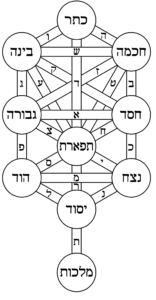
What distinguishes “the occult” from traditional folk magic, mainstream religious practice, or new age movements? There’s no quick or easy answer (if this is somehow the first page you’ve visited on this site, be prepared for this to be a running theme here).
The best way to even start to answer this question is to break down what the “occult” even is. The entry from The Dictionary of Gnosis and Western Esotericism is a good a place as any:
Occult/Occultism
Although the various terms and expressions based upon the latin “occultus” (“hidden, secret”, from occulere, “to cover over, hide, conceal”) tend to be used indiscriminately and are often confused in common parlance, they are the reflection of a historical development in the various stages of which they refer to different things. It is of particular importance to distinguish between the original adjective “occult”, and the substantive “occultism” that made its first appearance in the 19th century.
So, the term had different meanings at different points in history. Henry Cornelius Agrippa, writing in early 1500s Europe, opened his Three Books of Occult Philosophy with his own description as follows:
There is the outside, and the inside of philosophy; but the former without the latter is but an empty flourish; yet with this alone most are satisfied. To have a bare notion of a Deity, to apprehend some motions of the celestials, together with the common operations thereof, and to conceive of some terrestrial productions, is but what is superficial, and vulgar; but this is true, this is sublime, but occult philosophy; to understand the mysterious influences of the intellectual world upon the celestial, and of both upon the terrestrial; to know how to dispose, and fit ourselves so, as to be capable of receiving those superior operations, whereby we may be enabled to operate wonderful things, which indeed seem impossible, or at least unlawful, when as indeed they be affected by a natural power, and without either offense to God, or violation of religion.
This follows the general understanding of the time where “occult” meant something like “metaphysical”, or rather, what couldn’t be viewed directly with the naked eye. This relegated it to the power of God, spirits, angels, and other supernatural forces. Not all occult properties or phenomena were considered directly influenced by unseen entities. The “natural sciences” abounded with unknown mechanisms which philosophers and early thinkers attributed to natural or supernatural sources regardless of their “occult” status. Alchemy is an example where the forerunners of chemistry debated as to which reactions may have been spiritually or physically driven. As such, occult philosophy and science weren’t really separate from what we think of today as “science” or rationality up until the Enlightenment.
This is a good place to point out that this applies only in broad terms and specifically to the western world and western occultism. The Middle East had more significant contact with Indian and Asian cultures that influenced it to a certain extent, but further west into Europe this influence wasn’t as pronounced. Keep in mind as well that western occultism has been largely built on Abrahamic religions (Judaism, Christianity, and Islam) from the time of Constantine up until the Enlightenment. This monotheistic foundation wouldn’t have been compatible with most or all of eastern thought and practice. Practically speaking, Christians were actively persecuting each other as well as their Abrahamic cousins; it’s unlikely something as radically different as the would have gone over well even if the cultural contact wasn’t restricted by distance and technology of the time.

Before I jump over the Enlightenment, let me linger on that question of the occult versus mainstream religion. Going back to Agrippa, that last line reads: “without either offense to God, or violation of religion”. While he did eventually recant his dalliances with magic and the occult later in life, Agrippa was walking an extremely fine line when writing his massive work on occult philosophy. Luther had yet to publish his Theses when Agrippa was still writing the first of his three books. By the time all three were published, the Reformation was in full swing in his native Germany. Aside from these major schisms, inquisitions actively hunted down and killed supposed witches, wizards, and devil worshippers across Europe. Agrippa himself spoke out against such persecution though he thankfully never ran afoul of them himself (despite the nature of his work). Now, attitudes and tolerance toward deviations from mainstream religion varied wildly from place to place, even year to year, depending on exactly where you land in history. Generally speaking, however, it wasn’t a wise bet to on the outside of the norm.
Folk traditions likewise fluctuated in their acceptance. It was common for small communities to rely on “wise” men or women and their knowledge of herbs and traditional medicines. In times of stress, such as famine, plague, or drought, unfortunately these figures were often the first to be blamed. They were either scapegoated because they lived on the fringes of society, usually as widows or spinsters, or people assumed that their seemingly magical ability to heal could just as easily be used to cause harm. Branded as witches, it didn’t take much to condemn these folk practitioners to exile, punishment, or death.
These folk traditions persisted alongside Christianity in a seemingly contradictory balance. It was acceptable to use a ritual to ward off evil spirits even if it had come from pagan roots. In places like Ireland, early Christian missionaries often took local gods or folk heroes and described them as “saints” to appease the locals. Likewise, any supernatural creature or monster was relegated to the retinue of the devil. The same techniques to appease or ward off such entities, however, didn’t necessarily change with the new labels. If it had worked for a family for generations, why change it? This is where local traditions could run afoul of traveling inquisitors or outsiders. What had once been acceptable no longer was and the more remote villages and hamlets weren’t exactly subscribed to a “Heretics Monthly” newsletter. How someone was treated, whether they actually practices folk magic or not, had more to do with luck and their standing in the community in general.

As you can see, what occultism is and if it is acceptable or not depends on the individual judging it. Knowledge and experience can make the boundaries clearer, but keep in mind that the words and categories we make (especially now and with hindsight) are really just guidelines. They are a way to aid in the communication of complex ideas and not restrictions on them. With that in mind, if you want to better understand a folk or occult practice, put it in context. What time period are we talking about? Remember the further back in time you go the more dubious providence can be. What location and culture? What people have come and gone? What did they bring with them? Ideas move and migrate with people. It is only in the past couple decades that information has been so divorced from its place of inception.
Once you’ve placed the practice in the context of its time and place, the next step is to look at who is taking part in it. Is it something that only happens in royal courts and prestigious institutions? Is it an old widow that lives in a shack in the countryside? Is it a common practice that a lot of people take part in? Or is it done by one or just a few people, in secret, hidden from the majority? If someone talked about it in church, would there be gasps or nods?
Answering these questions should give you a good idea of the practice you’re scrutinizing. As a general rule, you can break it down by major periods in history:
![]() c. 4,000 BC – c. 700 AD
c. 4,000 BC – c. 700 AD
Before christianity became the dominant religion. Ancient Egypt and Greece, followed by the Roman Empire, are the most significant sources in this time. Unless it’s a mystery cult, most things from this period are essentially regular religions and/or folk practices. Mystery cults fit the technical definition of “occult” but really are their own thing altogether. A lot of later traditions say that their material dates to this period of time but most all of them are contemporaneous to these claims.
![]() c. 700 AD – c. 1250 AD
c. 700 AD – c. 1250 AD
The Islamic Golden Age. I talk a little bit about this in a history tangent on the Alchemy page.
![]() c. 1250 AD – c. late 1600s
c. 1250 AD – c. late 1600s
Christianity up until the Enlightenment. The Middle Ages set the foundation for the occult “Golden Age” of the Renaissance. If it was something that you would be burnt at the stake for doing, it was either a local folk tradition the Church wasn’t on board with or you had a slightly different theological viewpoint (see for example, the Cathars, a Gnostic based sect) and you were branded a heretic. If you were rich or nobility you could get away with a lot more controversial practices as long as you made assurances you were on the right side with the Church.
![]() 17th and 18th centuries
17th and 18th centuries
The Enlightenment. Most occult and esoteric practices die down or go underground.
![]() Circa 1840s
Circa 1840s
The Spiritualism movement begins. At first, this movement was focused on contacting the dead. As it grew, it became a sort of occult revival culminating with the likes of Madame Blavatsky and Aleister Crowley. This is when the modern usage of the term “occult” begins. Now that individuals aren’t as likely to be accused of heresy and burned at the stake and the prevailing culture isn’t obsessed with pure rationality, esoteric and occult practices start to come out of the dark and into mainstream culture. Neopaganism, the revival of pre-Christian practices largely based in ethnic and culture groups, is also starting to gain popularity.
![]() Circa 1940s-60s
Circa 1940s-60s
Wicca begins with Gerald Gardner and grows into a prominent movement. The Church of Satan is founded in California in the late 60s.
![]() 1970s
1970s
The “New Age” brings a significant amount of eastern influence into western esoteric practices and culture. This occurs alongside a glut of cults, new religious movements, communes, and a general explosion of counter-culture practices. A lot of people claim to know a lot of things in this age; most of them are making it up as they go along (which, to be fair, is true of any point in human history).
![]() 2000s-2020
2000s-2020
Our current age is seeing renewed interest in alternative spiritualities in mainstream and academic culture.
As you can see, there are a few gaps in this timeline. It is also exclusive to the path of western occultism. Trying to apply the term outside of the west (and to a small extent the near and Middle East) to areas in Africa, the Americas, and the Eastern world isn’t particularly accurate. For Africa and the Americas any native beliefs are likely to be religions or folk practices. The Eastern world has its own unique history that I am not currently qualified to comment on. There are two other major categories that don’t fit neatly into this timeline.

Esoteric and mystic practices in Judaism are their own thing entirely. There is some crossover with Christian mysticism, especially with Pico’s Christian Cabala in the Italian Renaissance, but really it is its own giant category. It starts thousands of years in the past and has been continuously developing since then in every time and place that the Jewish faith and people ventured.

The Colonial period also muddies the waters quite a bit, especially with the transatlantic slave trade. The forced relocation of people from western Africa, who where then dispersed among different tribes and ethnicities once they arrived in the Americas, made for some complicated religious practices. “Voodoo” is the popular term for a varied dispersion of the west African “Vodun” religion mixed with local customs and developed for generations after. Depending on where the original people were brought, it evolved into distinct customs in places like Haiti, Louisiana, Cuba, Puerto Rico, etc.
Santería, predominantly from Cuba, is another transatlantic frankenstein religion. Not only did the ancestors of these practices not have a choice in where they ended up, they also were forced to integrate Christianity (in the case of Santería, specifically Catholicism) into their lives and beliefs. As you can imagine, especially considering the disregard for recording these topics by the dominant society, it is extremely difficult to parse these religions into their disparate influences. Suffice it to say, none of these particularly fit with “esoteric” or “occult” definitions. They are essentially religions.
![]() As such, I highly recommend that you do not integrate aspects of them into your own practice without very thoroughly researching them first. This should include speaking with a native practitioner if possible.
As such, I highly recommend that you do not integrate aspects of them into your own practice without very thoroughly researching them first. This should include speaking with a native practitioner if possible.
![]()
Bibliography
Agrippa von Nettesheim, Heinrich Cornelius. Three Books of Occult Philosophy. Translated by James Freake, Llewellyn, 1993.
Betz, Hans Dieter, editor. The Greek Magical Papyri in Translation Including the Demotic Spells. Univ. of Chicago Pr., 1986.
Copenhaver, Brian P. Hermetica. Cambridge University Press, 1995.
Hanegraaff, Wouter J. Dictionary of Gnosis & Western Esotericism. Leiden, The Netherlands: Brill, 2006.
Levack, Brian P., editor. The Witchcraft Sourcebook. Routledge, 2004.
Partridge, Christopher, editor. The Occult World. Routledge, 2016.
Principe, Lawrence M. The Secrets of Alchemy. University of Chicago Press, 2013.
Schnurbein, Stefanie von. Norse Revival: Transformations of Germanic Neopaganism, Brill, 2016.
Scholem, Gershom. Kabbalah. Penguin Books, 1978.
Shumaker, Wayne. The Occult Sciences in the Renaissance: A Study in Intellectual Patterns. University of California Press, 1979.
—. Renaissance Curiosa. Medieval & Renaissance Texts & Studies, 1982.
Waters, Thomas. Cursed Britain: A History of Witchcraft and Black Magic in Modern Times. Yale University Press, 2019. JSTOR, www.jstor.org/stable/j.ctvmd866w.

